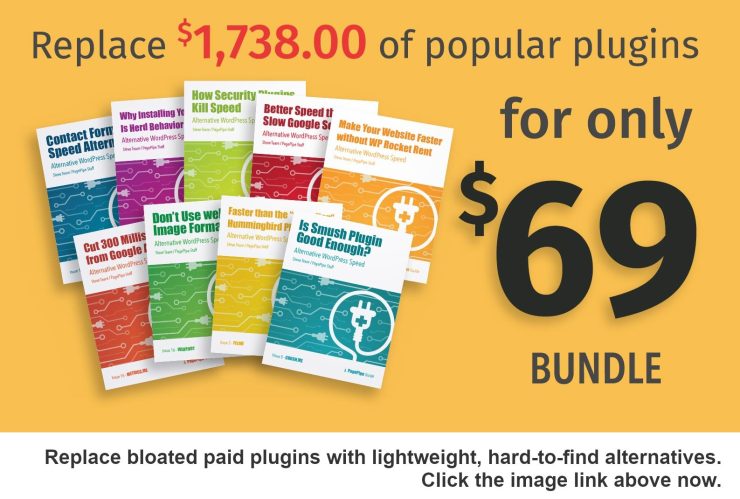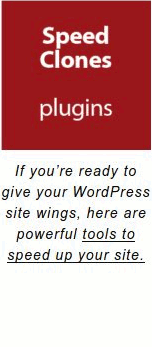If you search the phrase “Essential WordPress Plugins,” you’ll get about 7.4 million results. They all tend to regurgitate suggestions for the same old plugins. Copycat content. No wonder the identical plugins keep getting more installs. Even when better alternatives exist.
Toxic WordPress
Includes important tips for mobile speed without coding.
83 pp, 362k, 8.5 x 11 inches, PDF download.
Sorting and testing all the new plugins is too much work. So people don’t test. They assume. The assumption is “popularity” is good. For plugins, that is usually decided by looking at the number of active installs. Active installs is not a sign of quality or performance. It’s a standard of herd mentality.
Herd mentality, or mob mentality, describes how people are influenced by their peers to adopt certain behaviors. Examples of the herd mentality include nationalism, stock market trends, superstition, and home décor. —Wikipedia
To Engineer is Human by Henry Petroski is a book about engineering failures – mainly of buildings and bridge structures and airplanes during the 1980s and before. The main takeaway from the book is still applicable – and maybe even more so today: When technology or ideas are changing rapidly, there is never the opportunity to build a history or library of experience. This increases errors. Experience is what prevents accidents and disasters.
New upgraded versions of WordPress come out multiple times each year. And new plugins are being introduced at a breakneck pace. In 2013, 15,000+ plugins were in the WordPress plugin repository. In 2014, there were 29,000+ plugins in the repository. By 2015, the number was 35,000+. By Sep. 2016, over 46,000+ free plugins in the repository. And today, over 55,000 plugins. It’s difficult to stay on top of that rapid rate of change. It’s staggering.
To make a fast decision, it’s plainly easier to select from the most popular plugins – and consider that good enough. There are over 55,000 free plugins in the repository. And this doesn’t count any of the plugins available on GitHub where authors refused to go through the WordPress red-tape of acceptance.
You can choose any plugin from the TOP100 and from our experience it will be the slowest and most bloated plugin in its class. For example: #1 Akismet: 52M installs, #2 Contact Form 7: 42M installs, #3 Yoast SEO: 33M installs, #5 Jetpack: 28M installs. These are all heavy plugins and either directly or indirectly affect load time. We see these plugins installed on most slow sites.
Plugin popularity is rarely an indicator of good value. People assume they must be good. At one time, they were either the-only-game-in-town or repaired or compensated for WordPress deficiencies that later became solved with new WordPress versions. So even though the need for “repair” was gone or obsolete, the herd kept installing out of habit and myth. It became de-facto standard best practice.
Many recommended “essential” plugins have negative speed repercussions.
Our rule of thumb is: the more popular a plugin is (active installs), the higher the probability it’s a slow loading plugin. Why? We don’t know exactly why this correlates. But it holds up in our speed testing.
It’s the quality –not quantity– of plugins that slows down a site. Speed testing free plugins and themes is our specialty. Millions of herd-mentality WordPress plugins slow down the Internet, waste web resources, – and use up your precious time.
PagePipe.com (our blog) has 53 active plugins. It loads in under a half second in the USA and about 1.2 seconds for Europe (Pingdom.com). It can vary. That is using the cheapest, shared, old-magnetic GoDaddy hosting located in Arizona. No CDN. It will go even faster when GoDaddy updates to PHP 7.1 – but they’re running on outdated version 5.4. We share our server with 24 other domains. Why? We want to prove a point: You can use “speed strategy” rather than throwing money at load-time problems.
Our Mantra is avoid popular plugins. High number active installs means they’re the slowest.
We don’t know why “popular = bloated.” We speculate the plugin authors are content and apathetic to speed and quality. Popular plugins existed first and use old unoptimized coding techniques (obsolescence). They tend to get heavier with revisions instead of lighter (kludges).
The authors of old plugins don’t have competitive motivation to be lean for speed. This isn’t true for newer, less-installed, lighter plugins. Speed (load time) is now a desired feature we’re seeing more because of mobile devices. But fresh, fast plugins are not easy to find. There are 55,000+ plugins in the free directory. Wow! An ocean.
What is more characteristic of “goodness” is retention rate. That’s calculated by taking the active installs and dividing by the number of downloads for all time. A plugin with a retention of 20 percent is pretty good. If it’s 5 percent or less, it’s a danger sign. They were tried – and dumped.
Slow plugin’s download file size is a clue. Bigger files load slower. There are some exceptions – but they are few.
In our new Toxic WordPress, we present typical time-wasting herd plugins suggested on thousands of WordPress blogs. And we give you speed alternatives.
83 pp, 362k, 8.5 x 11 inches, PDF download.
Testimonial
… having read your book and browsed your site I had installed pretty much every plugin that you warn against using! I’ve spent I don’t know how much money buying plugins … I’ve reassessed the plugin functionality I actually need and struck a line through most that I had installed; the rest I think I can replicate with the lighter versions you’ve educated me about. … I am hugely grateful for the help and advice on your site and in your book: it’s great to know that good things are possible with WordPress on shared hosting!
—Jonathan Westwood, United Kingdom
Godspeed-
![]()
Steve Teare
performance engineer
February 2025
PagePipe Site Tuning Services for Speed
Instead of band-aid approaches, we drill down to the root cause of your slow site. This is origin optimization. Also known as site tuning. To do this, we analyze site components:
- Hosting
- Theme
- Plugins
- Scripts and third-party services.
- Images and media library.
- We minimize globally loading plugin effects.
Find out more details about Site Tuning – Get Speed!






